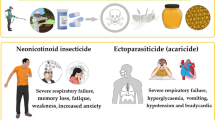Abstract
The effects of odors from the Field Vole upon the behaviour of conspecific individuals and sympatric mice and voles were tested with traps in forest cultivations. Three virgin subadult females (o.estr.), four adult females in post-partum-cycle (p.p.c) and three fertile males of the Field Vole served as donors of odors. Each donor vole was kept in a single cage. A spoon of wood shavings was taken from the surroundings of the nesting site from a caged individual and filled into a box trap (Sherman live trap) together with baits. Half a meter apart of each trap (b) contaminated with odor of one of the donor voles a trap with clean wood shavings was set control (k). Each pair of traps (b+k) was distributed in forest cultivations in a distance of ca. 10 m to the next pair of traps. All traps were decontaminated in a cleaning machine and dried at 100°C before they were used.
The results are presented in table 1. Traps containing odors of female Field Voles in post-partum-cycle were highly and significantly preferred from males, not only from conspecific voles, but also from males of sympatric species like the Bank VoleClethrionomys glareolus and the Yellownecked FieldmouseApodemus flavicollis. It is suggested that some less specific hormonlike pheromones can affect the behaviour of sympatric mammals in a similar way. The used odors were persistent. Nearly the same results were obtained with contaminated wood shavings filled in plastic bags and stored for four weeks at room temperature.
Zusammenfassung
In Forstkulturen wurden Kastenfallen, die Duftstoffe von verschiedenen Erdmäusen enthielten neben nichtbedufteten Fallen aufgestellt. Die mit Duftstoffen von weiblichen Erdmäusen im „post-partum-Zyklus” kontaminierten Fallen wurden besonders deutlich bevorzugt und zwar von geschlechtsreifen männlichen Artgenossen. Darüber hinaus wurden auch männliche Tiere von anderen Mäusearten in diese Fallen gelockt. Weibliche Erdmäuse aber auch Weibchen von anderen sympatrischen Mäusearten mieden diese Fallen. Ähnliche und weitgehend übereinstimmende Verhaltensweisen verschiedener Mäusearten wurden auch gegenüber Duftstoffen von männlichen Erdmäusen beobachtet.
Es wird vermutet, daß einige hormonähnliche Pheromone artübergreifend das Verhalten sympatrischer Mäusearten beeinflussen können. Die Wirkung dieser Duftstoffe war persistent. Ähnliche Ergebnisse wurden auch erzielt mit kontaminierter Einstreu, die etwa einen Monat in Kunststoffbeuteln bei Raumtemperatur gelagert worden war.
Similar content being viewed by others
Literatur
Bäumler, W., 1978: Über den Einfluß fremder Männchen auf die nestlingsmortalität bei der Erdmaus (Microtus agrestis L.). Anz. Schädlingskde, Pflanzenschutz, Umweltschutz51, 122–124.
Bäumler, W., 1986: Trüffeln, Mäuse und Testosteron. Naturwiss. Rundschau39, 396–397.
Bäumler, W., 1990: Populationsentwicklung waldbewohnender Mäuse in Bayern. Anz. Schädlingskde., Pflanzenschutz, Umweltschutz63, 96–99.
Bruce, H. M. 1959: An exteroceptive block to pregnancy in the mouse. Nature, London184, 105.
Claus, R. 1987: Pheromone des Ebers. G. Fischer Verlag, 110 S.
Christiansen, E.;Doving, K., 1975: Pheromones in small rodents occurence and supposed usefulness in biological control. Biocontrol of rodents. Ecol. Bull.19, 221–227.
Daly, M.;Wilson, M.;Behrends, P., 1980: Factors affecting rodents responses to odours of strangers encountered in the field: Experiments with odour-baited traps. Behav. Ecol. Sociobiol.6, 323–329.
Eibl-Eibesfeldt, I., 1958: Das Verhalten der Nagetiere. In:Kükenthal: Handb. der Zool.8, (10), 13, 1–88.
Hock, V., 1986: Über den Einfluß von Duftstoffen (Pheromonen) auf Verhalten und Entwicklung der Rötelmaus (Clethrionomys glareolus) und sympatrischer Arten. Diplomarb. Forstwiss. Fak. Univ. München 84 S.
Sachs, L., 1970: Statistische Methoden. Springer-Verlag, Berlin, Heidelberg, New York, 103 S.
Whitten, W. K., 1956: Modification of oestrus cycle of the mouse by external stimuli associated with the male. J. Endocr.13, 399–404.
Author information
Authors and Affiliations
Rights and permissions
About this article
Cite this article
Bäumler, W. Über das Verhalten sympatrischer Mäusearten gegenüber Duftstoffen der Erdmaus (Microtus agrestis L.). Anz. Schadlingskde., Pflanzenschutz, Umweltschutz 70, 105–107 (1997). https://doi.org/10.1007/BF02119599
Issue Date:
DOI: https://doi.org/10.1007/BF02119599




